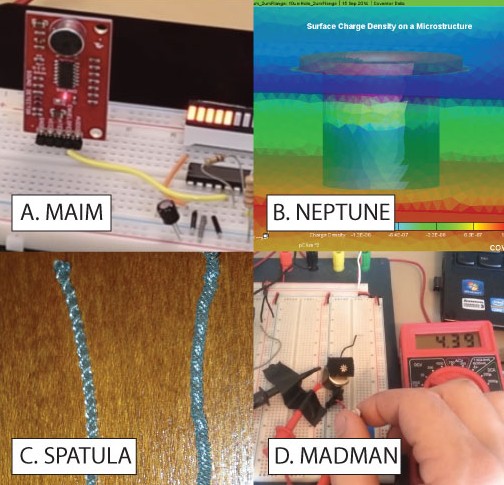We had four independent study* students this past summer. Students met weekly in the boardroom to troubleshoot and perfect their plans for world domination. Three of the projects provided new materials for our embedded systems course while helping out with our research, and one was a more classic research project where we needed a computer simulation done. The images above are based on their projects:
A. Reese Sexton: MAIM (Microcontroller Analog Input Module)
B. Jordan Meyer: NEPTUNE (Nanoporous Electroosmotic Pump To Usurp Nafion Electrodes)
C. Martin Dombi: SPATULA (Spiral Polymer Actuator Tester for Ultra Light Applications)
D. Sherman Dowell: MADMAN (Microcontroller-Based Acoustic Device for Making and Analyzing Noise)
*Students in the Speed School can receive 500- and 600- level course credit for individual lab projects. Ask about ECE 593/693!
A. Reese Sexton: MAIM (Microcontroller Analog Input Module)
Reese developed analog-to-digital code examples for the Atmel XMEGA microcontroller in our embedded systems course. To get his hands on some analog data, he used this SparkFun sound sensor module — Works great for alerting a system when there’s a sudden loud noise! The ECE412 students will benefit from his step-by-step guide. MAIM also connects up to the MADMAN project; it’s a highly portable system for collecting sounds. Now to store and analyze the data–any ECE412 students need a project?
B. Jordan Meyer: NEPTUNE (Nanoporous Electroosmotic Pump To Usurp Nafion Electrodes). Jordan ran a Coventorware simulation of a metallic spool-shaped tube to study its surface charge density. Coventorware software is designed to predict the electric, thermal, and mechanical behavior of microelectromechanical (MEMS) systems. Early results show that asymmetry in the spool’s shape should be able to drive single-direction fluid flows even with a symmetric AC field. Applications for arrays of these metal-lined nanopores include high-pressure electroosmotic pumps for driving flows in soft robotics.
C. Martin Dombi: SPATULA (Spiral Polymer Actuator Tester for Ultra Light Applications). Yes, a spatula can be more than a humble kitchen implement. Martin’s project is to drive coiled polymer actuators made from fishing line using the A3BUXplained board. (We are interested in the Baughman group’s lightweight actuators as another possible way to drive our bistable mechanisms.) The MADMAN motor driver circuit should prove handy to generate the ~500 mA currents needed. Besides coding a driver system, and determining how to collect feedback on the actuators’ temperature and position, Martin is detailing how to spin up the spiral actuators with a drill. This DIY aspect may interest those ECE412 students who are seeking a break from the keyboard.
D. Sherman Dowell: MADMAN (Microcontroller-Based Acoustic Device for Making and Analyzing Noise). Sherman’s project is producing a printed circuit board and code for the ECE412 students and others to connect servo motors to their A3BUXplaned microcontroller boards. In MADMAN, the motor’s specific job is to drive a “scratcher” over a microtextured surface, so we can collect and analyze the acoustic signals and attempt to distinguish different scratched surfaces by their sounds. There’s also some mechanical design and laser cutting to turn rotary into linear motion. Applications include ID labels, human activity detection, large-scale touchscreens, and new kinds of strain sensors. ECE412 students will find Sherman’s pulse width modulation code examples handy for their projects.
